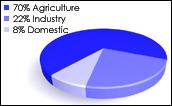

Planning for the Future |
|||
| Further refinements should allow for increasingly accurate estimates of groundwater storage using the GRACE technique. As an example, soil moisture simulations will become more and more realistic as models begin to incorporate data from additional sources, such as AMSR-E and new surface observations. Future efforts will also separate water stored in the so-called intermediate zone (the vertical span between the lowest level of soil moisture modeled and the top of the groundwater table), isolating the groundwater component even more accurately. Intermediate zone storage is still not well understood and scientists must do more work in that area to refine our understanding of this component of total water storage so that it can be represented realistically in models. As time progresses, Rodell and his colleagues hope that these improvements will allow the GRACE technique to be used for smaller spatial areas and shorter time scales. Scientists have conceived of several possible follow-on missions to GRACE, which would carry even more advanced technology and should allow them to remotely measure water storage in regions the size of a county. Rodell believes that the most effective means of improving the utility
of the GRACE technique will be through data assimilation, bringing
together the best observations and incorporating them into the best numerical
models of the land surface. “[Data assimilation] is probably the
best hope for maximizing the value of GRACE observations for hydrological
research and applications, and that’s what I am working on right
now,” Rodell states. |
|
||
|
As the new information from GRACE becomes assimilated into forecast models, the simulations produced will become more useful for predicting future conditions. These improvements will lead to increasingly accurate forecasts of water storage change that scientists can make with longer lead times, so that by the year 2010 water resource planners will have access to much more detailed and dependable information than they have at present. Better information will, in turn, lead to an improved ability to regulate water resources and help ensure that sufficient quantity is present for the many needs of society—including irrigation for agriculture, municipal supplies, and industry. Better water storage monitoring on a global scale should also help scientists improve our ability to predict, plan for, and respond to extreme events, such as floods and drought.
|

Agriculture places the largest demand on the world’s available water, using as much as 70 percent of the total water resources (see graph above). Many agricultural applications, such as irrigation (left), draw their water from underground supplies. The continuation of agriculture in some areas of the world critically depends on these aquifers. (Graph by Alex McClung based on data from the United Nations Environmental Programme.) |